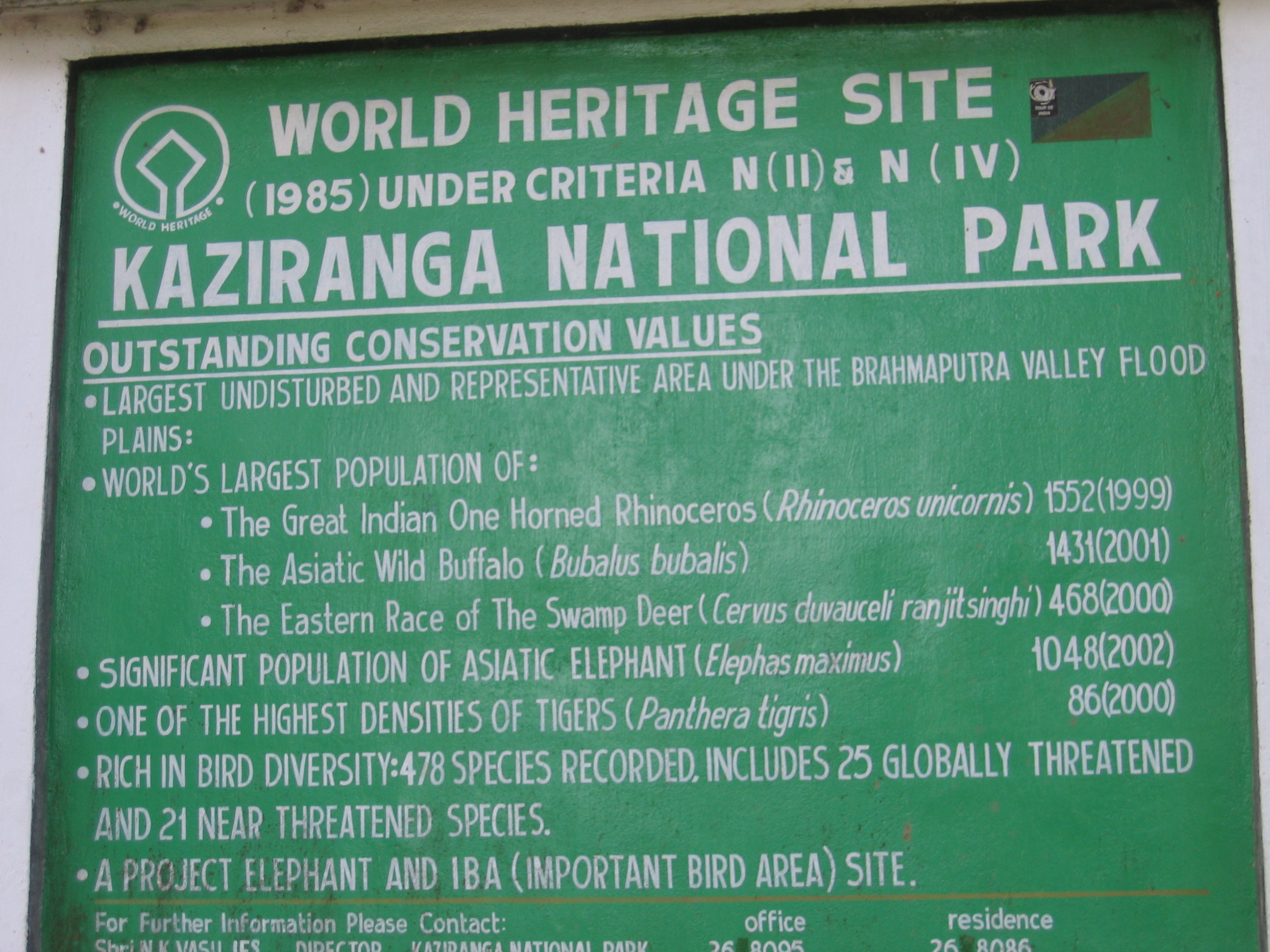Kaziranga National Park is home to the Indian One Horned Rhinoceros and is situated in the state of Assam, in the North-Eastern part of India.

One-Horned Rhinos at Kaziranga Park, Assam, India (Photo credit: Diganta Talukdar / Wikimedia Commons)
Kaziranga Park is a UNESCO World Heritage Site. Kaziranga National Park was declared a Park in 1905. Many wild animals and endangered species in India, including endangered animals and birds, can be seen at Kaziranga Wildlife Park.
Kaziranga Wildlife Park is home to Bengal Tigers and is part of Project Tiger. Kaziranga National Park has the maximum density of tigers among declared tiger reserves worldwide.
 A board proclaims Kaziranga National Park’s biological heritage, Assam, India. (Photo credit: Peter Andersen / Wikimedia Commons)
A board proclaims Kaziranga National Park’s biological heritage, Assam, India. (Photo credit: Peter Andersen / Wikimedia Commons)
The Fauna, which includes some of the endangered species in India are Elephants, tigers, barking deers, barasinghas or swamp deers, sambars, panthers, Bisons, Asiatic Wild Water Buffalos, leopard cats, otters, golden langurs, capped langur, etc. You can see many endangered species in Kaziranga Wildlife Sanctuary.

Black-necked stork, a Near Threatened (NT) bird species, is found here. Many birds, especially Avifaunal, an endangered species in India, are conserved here in the National Park of Kaziranga under Birdlife International’s initiative.
Many species of reptiles can be found here in Kaziranga Wildlife Sanctuary.
Elephant rides are available in the Wildlife Park of Kaziranga from Mihimukh, 3 kilometers from Kohora. Jeep Safari is also allowed in the Kaziranga National Park. You can take your Jeep if you want.
Pobitora Wildlife Sanctuary is a nearby sanctuary in Assam having the highest density of greater one-horned rhinoceros or The Indian rhinoceros in the world. Manas National Park or Manas Wildlife Sanctuary is a nearby UNESCO Natural World Heritage site in Assam bordering Bhutan, which also has One-Horned Rhinos.
How Do I Go to Kaziranga Wildlife Sanctuary?
The main gate of Kaziranga National Park is at Kohora, on National Highway NH 37.
Furkating Junction is the closest railway station, around 70 kilometers distance, with station code FKG.
The nearest airport to Kaziranga Wildlife Sanctuary is Jorhat Airport, alias Rowriah Airport at Jorhat. It is approximately 100 kilometers away. Only very few flights are available to this airport. Guwahati airport, 215 kilometers away, is a nearby airport with better connectivity.
What is the Ideal Time to Visit the Kaziranga National Park?
November to April is the ideal time to visit Kaziranga Park.
Is Accommodation Available Near Kaziranga Wildlife Park?
Baguri and Kohora on NH 37 offer different accommodation facilities (forest bungalows, hotels, lodges, etc.) to tourists. It is safer to book earlier accommodation as there is good demand on certain days.
Aranya Tourist Lodge, Bonani Tourist Lodge, and Bonashree are Government guest houses at Kaziranga (Kohora), close to the entry gate of the wildlife park. They may allow you to keep your luggage in their cloakroom for a fee, even if you are not staying there.

[…] sanctuary has the highest density of rhinos in the world whereas Kaziranga National Park is home to around 70% of the The Indian rhinoceros (highest concentration of rhinos). Total number […]
[…] Asatic onehorned Rhino. This national park has the second largest single horned rhinos in India. (Kaziranga National Park in the nearby state of Assam has the largest population of Indian one horned […]
[…] to Dampa Reserve Forests at around 70 kilometres distance. There is another airport at Silchar in Assam at 180 kilometres distance. ‘Silchar’ railway station in the state of Assam with […]
[…] Great One-horned Rhinoceros breeding has been done successfully in the Sanjay Gandhi Biological Park Patna several […]
[…] jungle cats, and wild water buffalos. It is the only place where a large number of these types of Indian Rhinoceros are seen, on the north banks of the […]